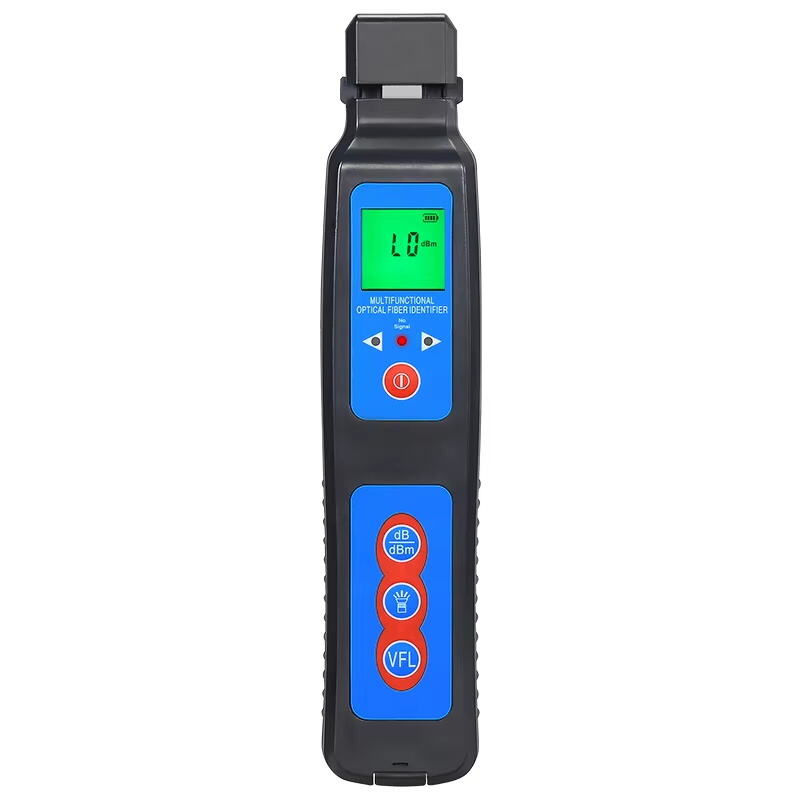फाइबर ऑप्टिक नेटवर्क में फाइबर आइडेंटिफायर को समझना
फाइबर आइडेंटिफायर फाइबर ऑप्टिक नेटवर्क्स में महत्वपूर्ण भूमिका निभाते हैं, क्योंकि ये तकनीशियनों को नेटवर्क ट्रैफ़िक में बाधा डाले बिना विभिन्न फाइबर्स को एक दूसरे से अलग करने में मदद करते हैं। मूल रूप से, ये उपकरण केबलों से होकर गुजरने वाले प्रकाश संकेतों का पता लगाते हैं, ताकि कर्मचारी सक्रिय केबलों को बिना कुछ भी खींचे या डेटा प्रवाह रोके उन्हें पहचान सकें। जो लोग लाइव नेटवर्क पर काम कर चुके हैं, वे जानते हैं कि मरम्मत या निदान के समय यह कितना महत्वपूर्ण है। इससे सेवाएं ऑनलाइन बनी रहती हैं, जबकि आवश्यकतानुसार विशिष्ट फाइबर्स की जांच और मरम्मत होती है। अन्य सभी को बंद किए बिना व्यक्तिगत तंतुओं पर काम करने की क्षमता कंपनियों के लिए समय और धन बचाती है, जो अपने संचालन में निरंतर कनेक्टिविटी पर निर्भर करती हैं।
रखरखाव कार्य के दौरान फाइबर आइडेंटिफायर तब अपना असली कमाल दिखाते हैं जब वे नेटवर्क डाउनटाइम को काफी कम कर देते हैं। शोध से पता चलता है कि इन आइडेंटिफायर्स को लागू करने से डाउनटाइम लगभग आधा हो जाता है, जिससे दैनिक आधार पर संचालन की दक्षता में काफी अंतर आता है। तकनीशियन को सक्रिय फाइबर्स की पहचान करने में अनुमान लगाने की आवश्यकता नहीं होती है, इसलिए समस्याओं का समाधान तेजी से होता है और सेवाएं लंबे समय तक ऑनलाइन बनी रहती हैं। इसके कारण नेटवर्क के समग्र प्रदर्शन में सुधार होता है। आज फाइबर ऑप्टिक सिस्टम संचालित करने वाले किसी भी व्यक्ति के लिए अच्छे फाइबर आइडेंटिफायर होना केवल उपयोगी ही नहीं है, बल्कि लगातार व्यवधान के बिना सब कुछ सुचारु रूप से चलाने के लिए यह लगभग आवश्यक भी है।
मुख्य कार्य फाइबर पहचानकर्ता फाइबर ऑप्टिक नेटवर्क रखरखाव के लिए
एक्टिव फाइबर्स में सिग्नल डिटेक्शन काम करता है, नियमित फाइबर्स की तुलना में अलग तरीके से, और यह क्षमता फाइबर आइडेंटिफायर्स के संचालन के मूल में है। मूल रूप से, ये उपकरण फाइबर ऑप्टिक केबलों से गुजरने वाले प्रकाश स्तरों में छोटे उतार-चढ़ाव को पकड़कर सिग्नल्स का पता लगाते हैं। यह दृष्टिकोण उन समस्याओं को पकड़ने में वास्तव में उपयोगी साबित होता है, जब वे गंभीर मुद्दों में बदलने से पहले होते हैं। उद्योग के आंकड़े दिखाते हैं कि शुरुआती खामियों को पकड़ने से रखरखाव खर्च कम हो जाता है, जबकि समग्र रूप से सिस्टम सुचारु रूप से चलते हैं। बड़े नेटवर्क चलाने वाली कंपनियों के लिए, इस तरह की प्रोएक्टिव निगरानी सुचारु संचालन और महंगी बंद अवधि के बीच का अंतर बनाती है।
नेटवर्क घटकों की पहचान करते समय भी सेवाओं को जारी रखना तकनीशियनों के लिए एक प्रमुख चिंता का विषय बना हुआ है जो फाइबर सिस्टम पर काम करते हैं। फाइबर आइडेंटिफायर के उपयोग से तकनीशियन यह पता लगा सकते हैं कि कौन से फाइबर सक्रिय रूप से डेटा संचारित कर रहे हैं, बिना सिग्नल को पूरी तरह से बंद किए। अधिकांश कंपनियां मानक रखरखाव प्रोटोकॉल के हिस्से के रूप में इस दृष्टिकोण का पालन करती हैं, और फील्ड रिपोर्ट्स के अनुसार, इन विधियों के सही उपयोग के दौरान कोई स्पष्ट सेवा बाधित होने की सूचना नहीं मिली है। आज के उच्च गति वाले नेटवर्क के लिए, इस तरह के बिना बाधित संचालन का बहुत महत्व है। जब व्यापार को अपने कनेक्शन को 24/7 चालू रखने की आवश्यकता होती है, तो छोटे से छोटा आउटेज भी ऑपरेशनल और ग्राहक के दृष्टिकोण से प्रमुख समस्याएं पैदा कर सकता है।
जब आपको जटिल नेटवर्क स्थितियों से निपटना हो और विशेष रूप से कई फाइबर इंस्टॉलेशन के साथ काम करना हो, तो सही स्थान सूचना प्राप्त करना बहुत महत्वपूर्ण होता है। घने नेटवर्क पर एक नज़र डालें जो विभिन्न प्रकार के फाइबर से भरे होते हैं। यह निर्धारित करना बहुत महत्वपूर्ण हो जाता है कि हम किस फाइबर की बात कर रहे हैं। बड़े डेटा केंद्रों या दूरसंचार नेटवर्क के अंदर तो यह समस्या और भी बढ़ जाती है, जहां सभी फाइबर एक दूसरे के समानांतर चल रहे होते हैं। अगर आप इन्हें आपस में मिला दें, तो चीजें तेजी से गलत होने लगती हैं। इसीलिए फाइबर आइडेंटिफायर की आवश्यकता होती है। यह सारी उलझनों को सुलझा देता है ताकि नेटवर्क प्रबंधकों को यह पता लगाने में कई घंटे न बिताने पड़ें कि कौन सा केबल कहां जाता है। इससे सभी के लिए जीवन बहुत आसान हो जाता है।
फाइबर पहचानकर्ता का उपयोग नेटवर्क रखरखाव में लाभ
फाइबर पहचानकर्ता त्रUBLEशूटिंग क्षमता को महत्वपूर्ण रूप से बढ़ावा देता है, जो नेटवर्क बंदी के दौरान तेज प्रतिक्रिया समय सक्षम करता है। उदाहरण के लिए, कई टेलीकॉम कंपनियों ने फाइबर आइडेंटिफायर्स के उपयोग से बंदी की अवधि में कमी के बारे में रिपोर्ट की है, जो चल रहे सेवाओं को बिना बाधित किए त्वरित रूप से समस्यापूर्ण फाइबर को पहचानते हैं। यह तेज पहचान प्रक्रिया डाउनटाइम को कम करती है और समग्र सेवा की कुशलता में सुधार करती है।
फाइबर आइडेंटिफायर्स में रखरखाव की दक्षता बढ़ाने की बहुत क्षमता होती है, जिस कारण यह किसी भी इंस्टॉलेशन प्रोजेक्ट के लिए विचार करने योग्य होता है। अध्ययनों से पता चलता है कि तंतु नेटवर्क की स्थापना या मरम्मत करते समय तकनीशियन को काफी समय की बचत होती है, क्योंकि ये उपकरण सक्रिय फाइबर की पहचान और पुष्टि करना बहुत आसान बना देते हैं। कनेक्शन की मैन्युअल जांच में कई घंटे बिताने के बजाय, रखरखाव दल तेजी से काम पूरा कर लेते हैं। बचाया गया समय केवल सैद्धांतिक नहीं है, बल्कि कई क्षेत्र कार्यकर्ता उचित फाइबर पहचान उपकरणों के साथ काम करने पर अपने कार्यभार में लगभग आधा कमी बताते हैं।
फाइबर ऑप्टिक नेटवर्क पर काम करते समय, सुरक्षा कभी भी एक अतिरिक्त विचार नहीं होनी चाहिए, और फाइबर आइडेंटिफायर मैनुअल निरीक्षण कार्य से जुड़े जोखिमों और उन परेशान करने वाले कार्यस्थल दुर्घटनाओं को कम करने में अहम भूमिका निभाते हैं, जिनसे हम सभी बचना चाहते हैं। ये उपयोगी उपकरण सेवाओं के ठीक से काम कर रहे होने की जांच करते समय फाइबर को छूने की आवश्यकता को समाप्त कर देते हैं, जिसका अर्थ है कमजोर तंतुओं को नुकसान पहुंचाने या कर्मचारियों को चोट पहुंचाने की कम संभावना। अधिकांश तकनीकी कंपनियों ने अपने मानक सुरक्षा प्रोटोकॉल के हिस्से के रूप में फाइबर आइडेंटिफायर अपनाना शुरू कर दिया है क्योंकि ये पुरानी विधियों की तुलना में बेहतर काम करते हैं। अंततः, कोई भी रोक-टोक को रोकथाम योग्य दुर्घटनाओं के कारण होने वाले नुकसान से निपटना नहीं चाहता।
ऑपरेशनल सेटिंग्स में फाइबर आइडेंटिफायर्स का उपयोग
साइट पर फाइबर आइडेंटिफायर्स को ठीक से काम करने के लिए कुछ मूल सर्वोत्तम प्रथाओं का पालन करना आवश्यक है। लाइव फाइबर्स का पता लगाते समय पठन को सटीक रखने के लिए नियमित रूप से कैलिब्रेशन की आवश्यकता होती है, जिससे उन परेशान करने वाले नेटवर्क जांच के दौरान गलतियों में कमी आती है। प्रशिक्षण का भी महत्व है। तकनीशियन को उस मॉडल के साथ दिन-प्रतिदिन के हेरफेर में अपनी राह जाननी चाहिए। अधिकांश कंपनियों ने पाया है कि अच्छी तरह से प्रशिक्षित कर्मचारी समस्याओं का त्वरित पता लगाते हैं और महंगे उपकरणों को नुकसान पहुंचाने से बचते हैं। परिणाम? निश्चित रूप से अधिक विश्वसनीय नेटवर्क परीक्षण के परिणाम, लेकिन एक अन्य लाभ भी है जिसके बारे में इन दिनों कोई ज्यादा चर्चा नहीं करता – उचित रूप से बनाए रखे गए फाइबर आइडेंटिफायर्स को बदलने के बीच अधिक समय तक चलने की क्षमता होती है, जिससे समय के साथ धन की बचत होती है।
जब फाइबर आइडेंटिफायर्स को मानक नेटवर्क रखरखाव उपकरणों के साथ जोड़ा जाता है, तो नेटवर्क के प्रदर्शन और भरोसेदारी के मामले में वास्तव में उनकी क्षमता बढ़ जाती है। संगठनों को बहुत मूल्य प्राप्त होता है जब ये आइडेंटिफायर्स ऑप्टिकल टाइम डोमेन रिफ्लेक्टोमीटर्स (वे OTDR उपकरण जिनके बारे में हर कोई जानता है) और नियमित नेटवर्क एनालाइज़र्स के साथ काम करते हैं। इस सभी उपकरणों को एक साथ रखने से पूरे नेटवर्क में क्या चल रहा है, उसे देखने के लिए कुछ ऐसा बन जाता है जो एक पूर्ण टूलबॉक्स के समान होता है। इसका सबसे बड़ा लाभ यह है कि समस्याओं को उनके प्रमुख समस्या बनने से पहले ही पकड़ा जा सकता है, जिसका अर्थ है कि भविष्य में कम अप्रत्याशित समस्याएं आएंगी। तकनीकी टीमें जो फाइबर आइडेंटिफायर्स को अपने मौजूदा उपकरणों के साथ जोड़कर काम करती हैं, वे समस्याओं को तेज़ी से पहचानती हैं और बिना समय बर्बाद किए उनका समाधान कर देती हैं। रखरखाव पूरे रूप से सुचारु रूप से होता है क्योंकि तकनीशियनों को शुरुआत से ही बेहतर जानकारी उपलब्ध होती है बजाय इसके कि यह अनुमान लगाने की कोशिश करें कि समस्या कहां छिपी हो सकती है।
निष्कर्ष: नेटवर्क में्टेनेंस में फाइबर आइडेंटिफायर्स का भविष्य
ऑप्टिकल फाइबर तकनीक इन दिनों तेजी से बदल रही है, जिसका मुख्य कारण यह है कि ऑटोमेशन और एआई (AI) को नेटवर्क प्रबंधन के तरीकों में लगातार शामिल किया जा रहा है। हम देख रहे हैं कि स्मार्ट नेटवर्क्स की ओर एक बड़ा संक्रमण हो रहा है, जो मूल रूप से स्वयं चल सकते हैं और शीर्ष प्रदर्शन प्रदान कर सकते हैं, बिना लगातार मानव देखरेख की आवश्यकता के। इसका अधिकांश भाग ऑप्टिकल प्रदर्शन निगरानी (ऑप्टिकल परफॉर्मेंस मॉनिटरिंग) जैसी चीजों में मशीन लर्निंग के अधिक सामान्य होने से संबंधित है। नेटवर्क ऑपरेटर्स को ऐसे सिस्टम्स की आवश्यकता होती है जो विशाल डेटा मात्रा को संभाल सकें और त्वरित रूप से समायोजित हो सकें, इसलिए वे अपने फाइबर बुनियादी ढांचे में समस्याएं आने पर निरंतर निगरानी और त्वरित सुधार के लिए एआई उपकरणों का सहारा ले रहे हैं। कुछ कंपनियों ने इन स्मार्ट निगरानी प्रणालियों को लागू करने के बाद मरम्मत लागत में 30% से अधिक की कमी की सूचना दी है।
कई उद्योग अंदरूनी लोगों का मानना है कि आने वाले वर्षों में फाइबर पहचान उपकरणों में प्रमुख परिवर्तन होने वाले हैं। अधिकांश विश्लेषकों का मानना है कि ये नए उपकरण केवल फाइबर को सटीक रूप से चिन्हित करने में बेहतर नहीं होंगे, बल्कि वे वर्तमान नेटवर्क सेटअप के साथ बहुत बेहतर ढंग से काम करेंगे। बड़ी तकनीकी कंपनियों ने हाल ही में लाखों डॉलर अनुसंधान एवं विकास में लगाए हैं, ऐसी प्रणालियों के विकास का लक्ष्य रखा है जो केवल समस्याओं को होने के बाद ठीक करने से अधिक काम कर सकें। कुछ प्रोटोटाइप पहले से ही यह दिखाने में सक्षम हैं कि वे नेटवर्क ऑपरेटरों के लिए वास्तविक परेशानी पैदा करने से दिनों पहले संभावित समस्याओं का पता लगा सकते हैं। ऐसा क्या संभव बना रहा है? इसका अधिकांश श्रेय देश भर में शीर्ष तकनीकी फर्मों और विश्वविद्यालयों के बीच बन रहे साझेदारियों को जाता है। ये सहयोग विभिन्न प्रकार के ज्ञान को एक साथ लाते हैं जो पहले उपलब्ध नहीं थे, जो वास्तविक परिस्थितियों में फाइबर पहचानकर्ताओं के द्वारा वास्तव में क्या किया जा सकता है, उसे आगे बढ़ाने में मदद कर रहे हैं।
सामान्य प्रश्न
फाइबर पहचानकर्ता क्या है?
एक फाइबर पहचानकर्ता फाइबर ऑप्टिक नेटवर्क में व्यक्तिगत फाइबर को पहचानने और प्रबंधित करने के लिए एक उपकरण है जो नेटवर्क ट्रैफिक को बिना बाधित किए फाइबर में ऑप्टिक संकेत का पता लगाता है।
फाइबर पहचानकर्ता कैसे काम करता है?
फाइबर आइडेंटिफायर्स कार्य करते हैं सक्रिय फाइबर में प्रकाश तीव्रता के छोटे-छोटे परिवर्तनों को पकड़कर, जिससे तकनीशियन विशिष्ट जीवित फाइबर को संकेत प्रसारण को बंद किए बिना पहचान सकते हैं।
फाइबर आइडेंटिफायर्स क्यों महत्वपूर्ण हैं?
फाइबर आइडेंटिफायर्स महत्वपूर्ण हैं क्योंकि वे नेटवर्क डाउनटाइम को कम करते हैं, सेवा सततता को बनाए रखते हैं और अपरिवर्तन खर्च को कम करते हैं, जिससे नेटवर्क की कुल प्रदर्शन और विश्वसनीयता में सुधार होता है।
क्या फाइबर आइडेंटिफायर्स नेटवर्क अपरिवर्तन जोखिम को कम कर सकते हैं?
हाँ, वे जोखिम को कम करने में महत्वपूर्ण भूमिका निभाते हैं, क्योंकि वे सेवा जाँच के दौरान सीधे फाइबर के प्रबंधन की आवश्यकता को हटा देते हैं, फाइबर के दमने या व्यक्तिगत चोट की संभावना को कम करते हैं।
फाइबर आइडेंटिफायर तकनीक में क्या उन्नतियाँ अपेक्षित हैं?
भविष्य में उन्नतियाँ उनकी सटीकता में सुधार करने, नेटवर्क ढांचे के साथ एकीकरण करने, और AI-आधारित समाधानों का उपयोग करके भविष्यवाणी आधारित समस्या रोकथाम और वास्तविक समय में पर्यवेक्षण करने के लिए की जाएंगी।







